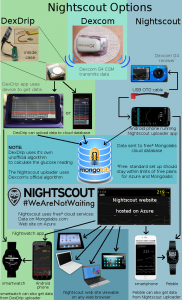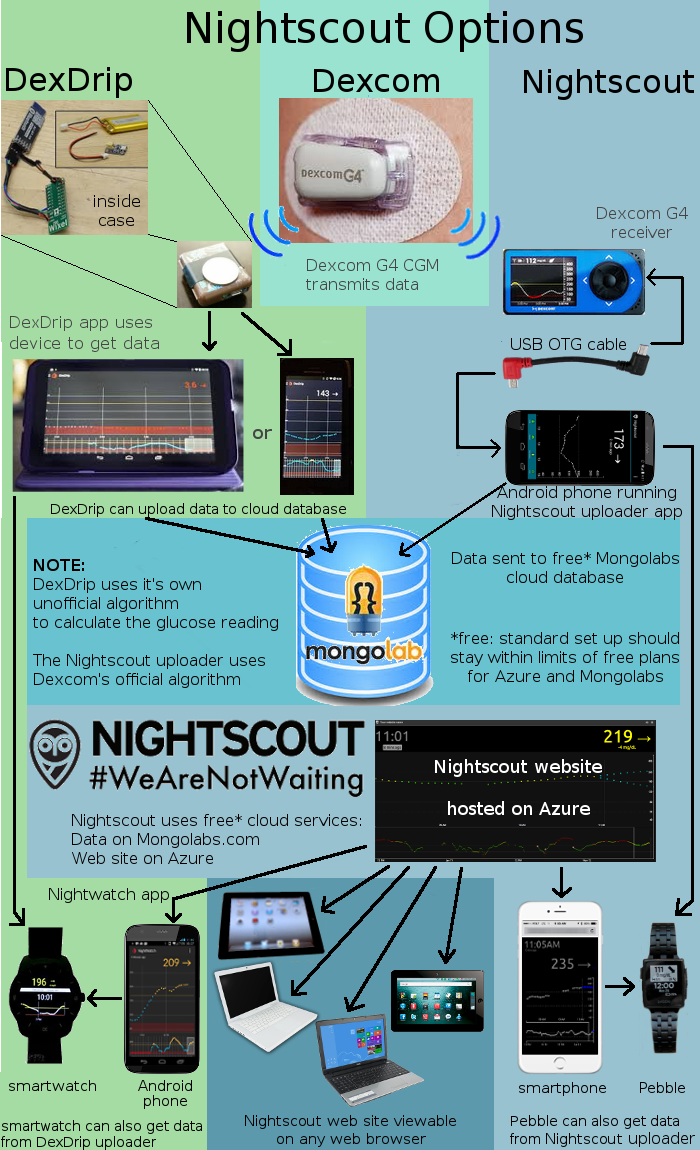NOTE: xDrip used to be called DexDrip so you might find some references to the old name in this article.
 My last three xDrip posts (introduction, components and building) have generated a few questions of which device, phone, cable or application goes where, so I thought I’d create a graphic of how I see it all working (well) together.
My last three xDrip posts (introduction, components and building) have generated a few questions of which device, phone, cable or application goes where, so I thought I’d create a graphic of how I see it all working (well) together.
Scroll down for the large version of the graphic…don’t try and read that one on the right 🙂
Here’s a key to the graphic to help you see what comes from where:
Dexcom G4 CGM system
The Dexcom G4 continuous glucose monitoring system which Nightscout and xDrip are currently based on.
The Dexcom G4 continuous glucose monitoring system which Nightscout and xDrip are currently based on.
Nightscout
A full system of interfaces, cables, phones and applications to pull Dexcom glucose values from the Dexcom receiver, upload the data to the Internet and allow remote CGM monitoring via websites, phones, smartwatches. Designed and developed by people within the collective of Diabetes Parents who now front the Nightscout Foundation
A full system of interfaces, cables, phones and applications to pull Dexcom glucose values from the Dexcom receiver, upload the data to the Internet and allow remote CGM monitoring via websites, phones, smartwatches. Designed and developed by people within the collective of Diabetes Parents who now front the Nightscout Foundation
xDrip
A do-it-yourself device and applications to retrieve data from the Dexcom CGM, using an independent algorithm to calculate the glucose reading, upload values to the same Internet database as used by Nightscout, to allow remote CGM monitoring. There is also a separate app (Nightwatch) which retrieves information from the Nightscout web site and relays info on to a smart watch. Designed and developed by Stephen Black.
A do-it-yourself device and applications to retrieve data from the Dexcom CGM, using an independent algorithm to calculate the glucose reading, upload values to the same Internet database as used by Nightscout, to allow remote CGM monitoring. There is also a separate app (Nightwatch) which retrieves information from the Nightscout web site and relays info on to a smart watch. Designed and developed by Stephen Black.
Mongolabs.com
A cloud-based database solution, used to store the CGM readings uploaded by either the Nightscout Uploader application or the xDrip application.
A cloud-based database solution, used to store the CGM readings uploaded by either the Nightscout Uploader application or the xDrip application.

Interested in further posts about this subject? Why not like this blog’s Facebook page and get notified of updates, or click ‘Follow’ using the button at the bottom-right of this page.
PLEASE READ THIS ADVISORY
a) Never make a medical decision based on a reading from any CGM device, whether certified (eg Dexcom) or not (eg xDrip). Always perform a fingerstick blood glucose check first.
b) xDrip is a DIY product, decide for yourself if you wish to use it. Build it, test it, test it again and use (if you want to) in conjunction with a certified receiver.
c) The fact that it is working for us does not mean it’s right for you.
d) Never build a xDrip for anyone else and never sell one.
e) The blogs are provided for information only. We are not endorsing it for use by others, nor promoting it, just merely publishing our information as well as answering questions from previous blog articles.
b) xDrip is a DIY product, decide for yourself if you wish to use it. Build it, test it, test it again and use (if you want to) in conjunction with a certified receiver.
c) The fact that it is working for us does not mean it’s right for you.
d) Never build a xDrip for anyone else and never sell one.
e) The blogs are provided for information only. We are not endorsing it for use by others, nor promoting it, just merely publishing our information as well as answering questions from previous blog articles.

Hi Kev,
Thanks for pulling together a great graphic – an excellent summary of how all this tech slots together. Although we’re only a few months in post diagnosis, it’s clear how liberating this tech could be to deliver additional monitoring capability on top of what’s feasible for families now.
As imminent Medtronic (604g + CGM) users, I just wondered if, during your research, you’d come across anything concrete on a similar solution for the Medtronic? I *think* the Guardian 2 Link transmitters – that should ship with the 604g – may be Bluetooth enabled, allowing them to talk to a future mobile app (prob the Guardian Mobile app that they’ve previewed in the States) and the pump. I’ll certainly be exploring when ours arrive next month (within the boundaries of our warranty of course 😉 )
Thanks,
Matt
Hi Matt, thanks for the comments. Not sure if MMCommander (https://github.com/jberian/mmcommander) might suit or not, or maybe MedtronicUploader (https://github.com/arbox0/MedtronicUploader)?
Just read your blog Matt, we were both there last Friday. We’re at the RHCH.
Thanks Kev – and thanks for comment on Little D too 🙂
I’ll take a closer look at those sites – I thought I read somewhere that they won’t work with the Medtronic Guardian transmitter, but I’ll contact the developers and try to find out more.
Hi Kev, thought you might like to know BBC Click had a short item on Nightscout today – you can find the programme on the BBC iPlayer (http://www.bbc.co.uk/iplayer/episode/b0520ny9/click-31012015). I’ve added my ramblings at http://littlet1d.blogspot.co.uk/2015/01/nightscout-wearenotwaiting-on-bbc-click.html 🙂
Thanks Matt, I saw it, thought Rachel did really well. Didn’t think much of JDRF getting in on the act with the vapourware which could in no way help solve the situation Rachel (and us) are trying to resolve with Nightscout. I can understand distancing themselves from Nightscout, that’s fair enough.
Thanks a lot